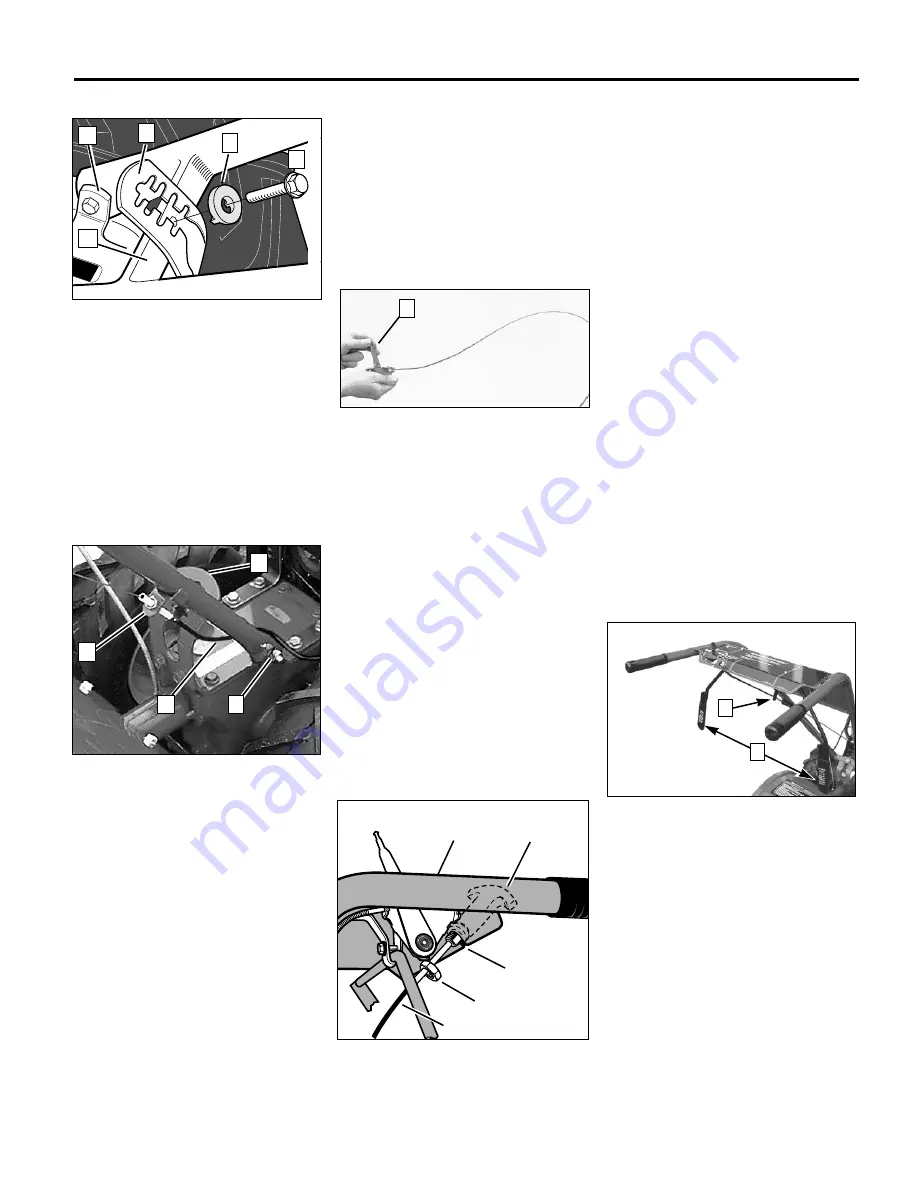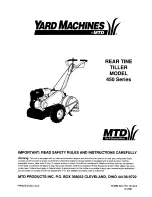
3. With forward clutch cable (N, Figure
2-4) on inside of handlebar, position
handlebar ends on outside of the two
mounting tabs (M, Figure 2-3) on trans-
mission top cover.
NOTE: The curved handlebar height
adjustment bracket appears as shown in
C, Figure 2-3 for non-electric start units.
For electric start units, the bracket is loos-
ened and moved to one side.
5. Loosely attach the handlebars to the
mounting tabs with two 3/8-16 x 1"
screws (heads of screws go to inside of
tabs), 3/8" flat washers and 3/8"-16 lock
nuts (O, Figure 2-4).
6. On electric start units, reattach the
height adjustment bracket (A, Figure 2-2).
Tighten both screws securely. Make sure
the handlebar cross-brace (B, Figure 2-3)
is under the bracket.
7. Move the handlebars up or down to
align the threaded hole in the cross-brace
with one of the four slots in the curved
height adjustment bracket. Place the
keyed washer (E, Figure 2-3) on the
flange head height adjustment screw (F)
with the raised keys (edges) of the washer
facing down.
8. Thread the height adjustment screw
(F, Figure 2-3) into the hole in the handle-
bar cross-brace, making sure that the
raised keys on the washer fit into the slot
on the height adjustment bracket.
Tighten the height adjustment screw
securely. Next, securely tighten the two
screws and nuts in the ends of the han-
dlebar (M, Figure 2-3).
9. To remove the tiller from its shipping
platform, first carefully unwrap the wheel
gear cable (with attached lever - see
Figure 2-5) from around the chassis.
Move the Wheel Gear Lever (G) to the
DISENGAGE position--this allows the
wheels to rotate. Use the handlebars to
roll the tiller off the platform.
NOTE: The Wheel Gear Lever will be
installed later in this procedure.
IMPORTANT: Use the DISENGAGE posi-
tion only when the engine is not running.
Before starting the engine, the Wheel Gear
Lever must be placed in the ENGAGE
position (see Section 3 for details).
STEP 3: ATTACH REVERSE
CLUTCH CONTROL CABLE
1. Carefully unwrap the reverse clutch
control cable (H, Figure 2-6) from its
shipping position and route it up along
the inside edge of the left side handlebar.
A knob and large hex nut (I) is installed
on the cable.
2. Insert the cable into the slot in the
control panel and fit the threaded assem-
bly into the hole in the slot (see Figure 2-
6). Be sure that the flat side of the
threaded assembly is aligned with the flat
side of the hole. Slide the hex nut (I) up
the cable and tighten it securely.
3. Test the function of the reverse clutch
control cable by pulling the knob out and
releasing it. The knob should return to its
neutral position against the tapered
bushing when it is released. If it doesn’t,
contact your local dealer or the factory for
technical assistance.
STEP 4: ATTACH FORWARD
CLUTCH CONTROL CABLE
1. Remove any fasteners (rubber bands,
tape, etc.) that may secure the Forward
Clutch Control levers (J, Figure 2-7) to the
handlebar.
2. The forward clutch control cable is
connected to the right-side handlebar (P,
Figure 2-4). Uncoil the cable wire and
insert the z-connector (at the end of the
spring - R, Figure 2-8) into the hole at the
end of the forward clutch control linkage
(K, Figure 2-7). You may need to move
the spring to a different angle in order to
get the z-connector into the hole.
Figure 2-6: Attach reverse clutch control
assembly to slotted hole in handlebar panel.
Figure 2-4: Attach handlebars.
Figure 2-5: Carefully unwrap Wheel Gear
Lever and move lever to DISENGAGE.
Figure 2-3: Forward clutch control cable not
shown for clarity.
7
Section 2: Assembly
C
N
P
O
E
F
➥
I
H
C
Left Side
Handlebar
Reverse Clutch
Control Knob
Slot in
Control
Panel
Figure 2-7: Forward Clutch Control levers
(J). Forward clutch control linkage (K).
K
B
M
J
G








































